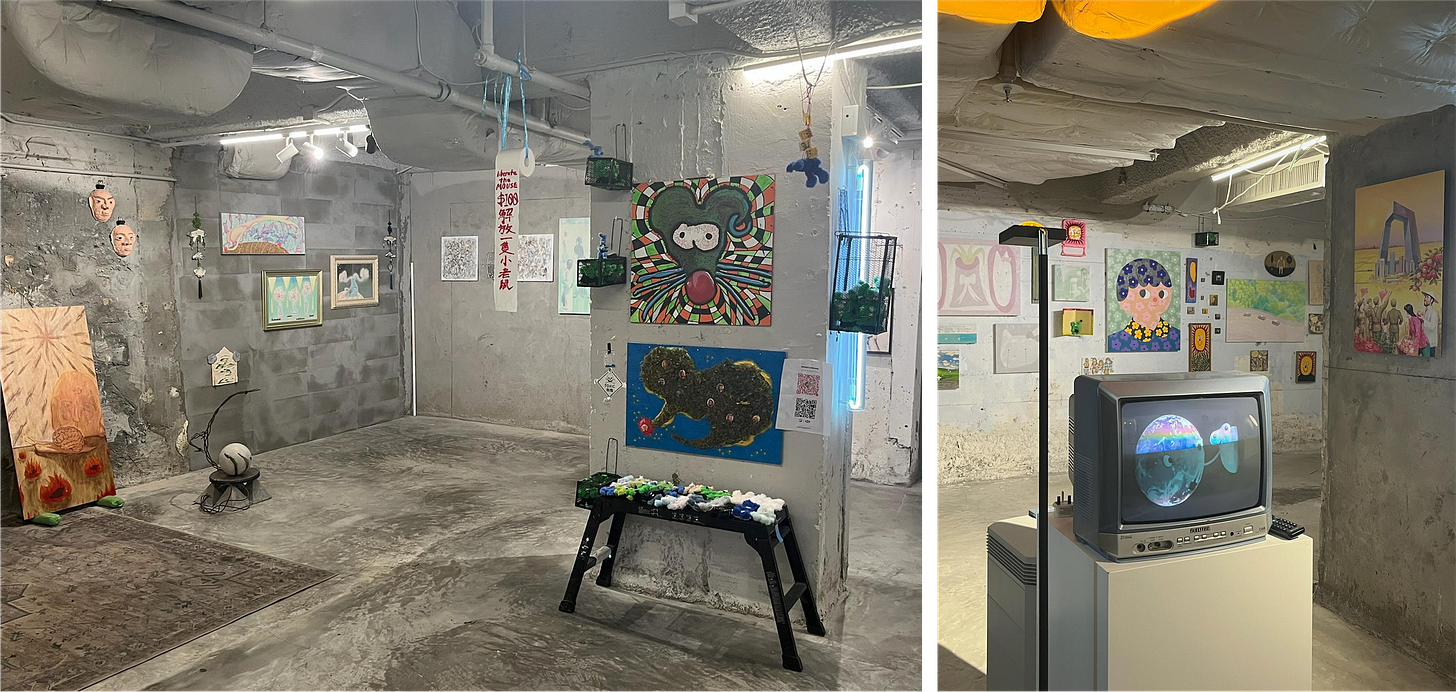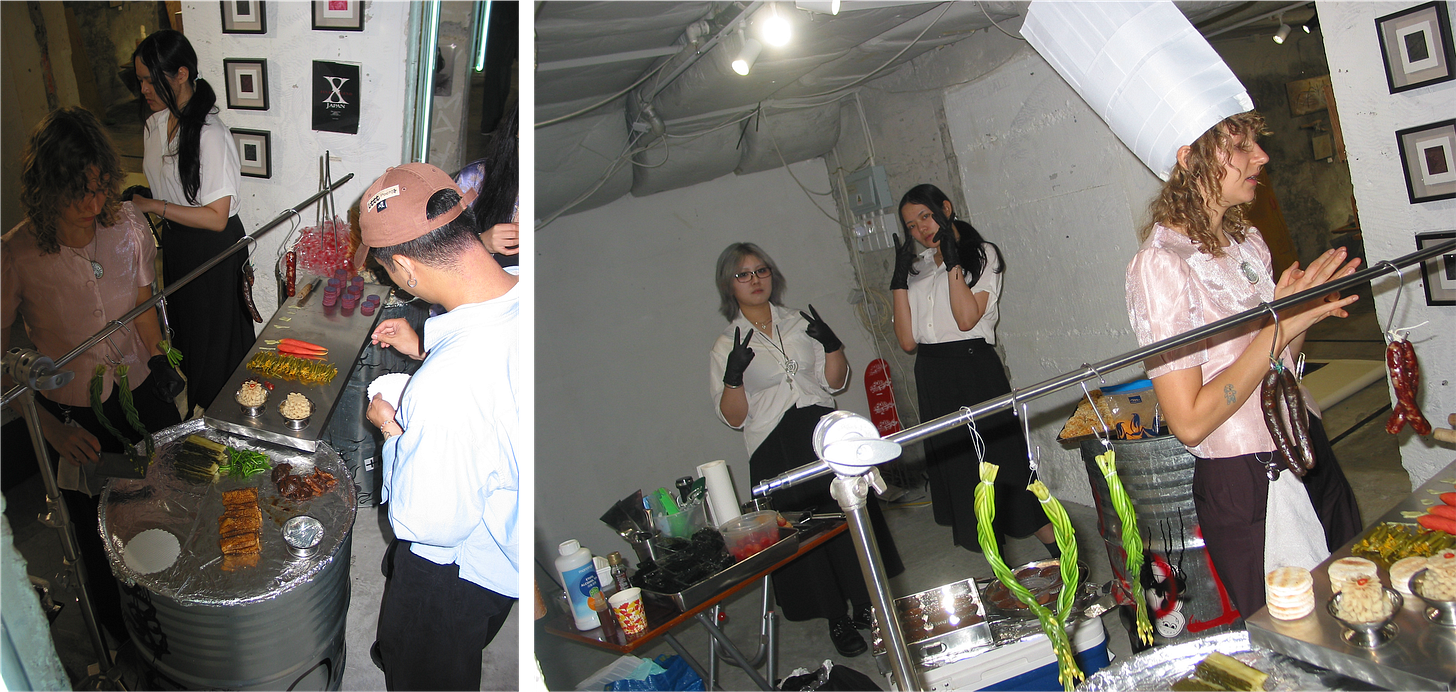Funding an Art Gallery With Satire and Mac and Cheese
N+ Museum, a guerilla gallery, is offering a bold proposition for how independent art can thrive against the industry’s commercialization.
Deep inside the mind of a tech bro, there’s a vision of the world where Dall-E and Midjourney are the world’s leading artists; a reality where creativity is automated at scale and every idea is algorithmically generated. If you have as much of a toe dipped into the art world, fears of a dystopian future where AI ravages creativity might be familiar. But pretend the bots don’t exist for a second and our world might not actually look that different.
“Most artists employed by the art market already operate eerily similar to the prompt driven nature of AI programs,” says online art critic Brad Troemel. Just as AI-image generators draw from a library of styles to generate visuals to appease users, commercial artists often adapt their work to popular styles in order to meet art consumer demands.
That tendency for commercialized, risk-free creation takes many forms, but in Hong Kong, there is one common thread uniting the most repetitive, uncreative art: “Galleries are pushing aesthetics that are very similar,” says Renee Lui. “There’s exhibitions of Hong Kong artists [showcasing] the same thing over and over again: nostalgia.”
Nostalgia bait works perfectly in appeasing art consumers in a rapidly changing city like Hong Kong, where economic prospects look increasingly gloomy. Renee, as an independent art curator, has seen much of it. But “It’s just not exciting,” she says. “It’s just frustrating for me to see how people are eating this up and putting a lot of money into this.”
Crisis calls for innovation, not regression. And a taste for new-ness isn’t being cultivated properly. When the art market is starved of originality, where might you find it? Probably not on the internet. The answer instead might lie in places where innovation is a natural consequence of existing conditions: indie galleries whose visions are often tested by scarce resources and forced to bloom in spite of it. At N+, a guerilla-gallery-meets-art-popup run by Renee and her partner, Louie Jaubere, I caught a glimpse of what that might look like.
N+ is not your typical art gallery. It has no physical location, and so instead, hosts shows in improvised venues around the city at an unspecified frequency, much like a wandering circus troupe. This year’s exhibit was held at Heath Mall, in the basement of Chungking Mansions—the setting of Wong Kar-wai’s Chungking Express (1994) and Fallen Angels (1995)—often (mistakenly) denigrated as Hong Kong’s ‘ghetto.’
Hanging on the walls were a few stitched rugs depicting Yoshitomo Nara-esque humanoid fruit caricatures. In the corner of the room, two potatoes on top of a red stool wired together by a chain. And in the middle—a purple baby crib endlessly shaking up and down, and (separately) plastic limbs hanging from a wooden ladder. I’m not quite sure if the latter was actually an artwork on display, or just props for the exhibit, but blurring the line between curation and creation is a regular practice for the gallery. There’s one sculpture of synthetic human organs—brain, eyes, heart, hands—neatly scattered on a mahjong table, but only the body parts are the actual art. The rest of the piece was simply “a curatorial choice,” Renee says.
“There’s no overarching theme,” says Louie. “ I was looking for something interesting, a fresher voice.” The exhibition is medium-agnostic and has only two criteria for curated works: that its creator is not a commercial artist, and that craftsmanship is visible to the naked eye.
“For me as a painter, that’s what I value and enjoy having in the space around me,” Louie adds. “If it’s something I can feel and touch, I respect that.”
“The gallery system is getting slowly outdated,” says Renee. “I’ve been working in the commercial art world for five years… the business model just doesn’t make sense.”
At a traditional gallery, half the sale goes to the artist while the other half goes to the gallery. But deal flow is rarely enough for galleries to shoulder rent, and neither is it enough to pay artists fairly. N+ circumvents this traditional model. By hosting in sponsored, impromptu spaces, they have no overhead rental costs. This also allows them to better compensate their artists: 80% of the artwork sale goes to the artist, 20% goes to the venue sponsor.
“It’s a labor of love,” says Louie. “Even if we sell things, we don’t get commissions.” But if no money goes to the curators, how does N+ get funded?
Soirees and cocktail parties usually belong in the realm of upscale, traditional galleries, but on a Friday evening in July, they somehow landed on N+’s agenda. In an effort to raise funds, Renee and Louie transformed their bootstrapped, travelling gallery into a VIP-exclusive party, with fundraiser tickets selling at 300HKD (38USD)
Walking into the venue at 7:30pm that evening, the first object on display was a dessert platter held together by a laboratory stand. In the middle of a room, a bartender (who apparently moonlights as a musician), passed freshly mixed cocktails with plum and sugarcane rum as the base. By around 8:15, dinner was served. Antonia, the head chef, banged her pen against an industrial barrel to get everyone’s attention. Now, all eyes were on her, and on the Mai Zi Lin-grade (NOT ‘Michelin’) menu of tapas served on top of foil-covered industrial barrels. Someone asked why the portion sizes were so small. Antonia snapped back, and standing poised with a tall toque blanche, said in a thick French accent that “it’s because of inflation.” I was later told the chef was actually German. (“I like how people believed her,” Louie says. “People think that she’s actually French.”)
Finally ready to eat, I asked for a toothpick but they didn’t have any. Instead, I was given a nail.
A soiree might be off-brand for an underfunded guerilla gallery, but mimicking the institutionalized art circuit and creating something more tongue-in-cheek was precisely the point. The nails, the Mai Zi Lin-star, and the pretentious French performance art were all DIY-techniques pushing Renee and Louie’s real motive: to mock and satirize the VIP events in the upscale contemporary art gallery scene. “It’s funny to see museums and galleries do fancy VIP events,” Renee says, recalling her own experiences. “They’re just big empty parties where everyone is talking to each other, trying to get more money.” The gallerists are selling art to high net-worth patrons, patrons sponsor galleries for clout—“this isn’t the kind of party that I’d genuinely enjoy. I want to change this with my own VIP party.”
The main dish of the evening was a tofu-laced mac and cheese bite, a more nutritious version of Kraft Mac and Cheese meals which, Louie and Renee say, are frequent in the life of a broke artist. The rest of the menu was similarly built around artist “struggle meals,” or, as the event announcement post says, “the kind of food you eat when rent’s due and all you’ve got is discounted shit you get from the wet market.” Affordable Chinese delicacies like fish skin and pickles were stacked onto a foil charcuterie board. Other menu highlights included a squid ink chicken liver pate topped with lychee jelly, and a tomato-egg rice onigiri.
As the night closed, Renee led a museum tour with visits to back alleys where local artists smoke cigarettes and into a dirty backroom housing unused supplies. “People should try to see through the pristine work that museums are doing,” she says. “And see the real labor of the people working in them.” The event’s premise was an anti-pretension, in finding ways to raise funds for independent art by subverting the practices that exclude it in the first place.
If you’re familiar with Hong Kong’s contemporary art scene, you might already notice the satire in the name already. The name N+ is a direct rip off of M+, the city’s largest and most funded contemporary art museum. Zoom into N+’s logo and you realize it’s literally a black-and-white copy of the M+ logo, with a wad of tape turning the M into an N.
“Less famous or up-and-coming people want to make fun of something that’s established. It’s innate in our nature,” Louie says. “It’s just funny. It’s silly to make fun of an actual institution. And when we did the second opening, people from the actual M+ came and told us we’re doing something interesting and important.”
Now might be a good time to address why THE CHOW is reporting an event nearly a month after it’s already happened. When I interviewed Renee and Louie in July, the pair were still speaking to the Food and Environmental Hygiene Department (FEHD). Someone had submitted an anonymous report on N+, and right before the event, Renee had to clear things up with an FEHD officer. It’s all settled now, but I was asked, formally, to publish this at least two weeks after the initial interview, and to let things cool off first.
But that’s the thing with guerilla art. It’s always adapting, always in constant negotiation with its surroundings. It thrives in spaces where it isn’t welcome, where external conditions test their limits and, paradoxically, force an unbridled creativity to bloom.
It’s also “not that serious,” says Louie. “Some people treat art like religion. For some people it’s an investment. But it’s not functional. It's not like a watch or a car. It’s art. It’s the least functional thing in the world. It's just people making shit up.”
When I asked Louie what the future was for the gallery, or if any more events were in the pipeline, he laughed and said, “I don’t know if there’s even gonna be a next one.”






